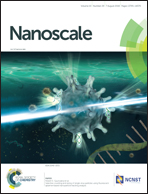Pushing the cycling stability limit of hierarchical metal oxide core/shell nanoarrays pseudocapacitor electrodes by nanoscale interface optimization†
Abstract
Three-dimensional hierarchical metal oxide core/shell nanowire arrays (HMONAs) have become promising pseudocapacitive materials due to their integrated smart architectures. However, these core/shell nanostructures have unsatisfactory structural stability and frequently suffer destruction during their fabrication process and their charge–discharge cycles, thus limiting their application lifespan. Herein, a general strategy based on the minimization of the lattice mismatch between the shell and the backbone at the nanoscale interface has been proposed to improve the cycling stability of the HMONAs. This strategy is achieved by a facile hydrothermal pretreatment under mild acidic condition, where a selective dissolution process occurs for interface optimization. To prove the concept, three typical HMONAs, α-MnO2 nanotube@δ-MnO2 nanosheet core/shell arrays, α-MnO2 nanotube@NiO nanosheet core/shell arrays and Co3O4@MnO2 core/shell nanoarrays, were synthesized for interface optimization. It was found that these thermodynamically unstable nanostructures in the shells of HMONAs can be selectively dissolved under a hydrothermal process, leading to enhanced stability of HMONAs. The comparison study indicates that all treated HMONAs exhibit excellent capacitance retention of 93.2% (MnO2@MnO2), 94.3% (MnO2@NiO) and 95.3% (Co3O4@MnO2) after 5000 cycles, which are 22.9%, 9.3% and 20.1% higher, respectively, than those of the untreated HMONAs. Furthermore, the symmetrical supercapacitors based on treated MnO2@MnO2 nanoarrays electrodes also demonstrate 92% capacitance retention after 5000 cycles, showing better comprehensive performance than their untreated counterpart (78% capacitance retention). The general strategy of nanoscale interface optimization provides new opportunities in pushing the cycling stability limit of HMONAs.



 Please wait while we load your content...
Please wait while we load your content...